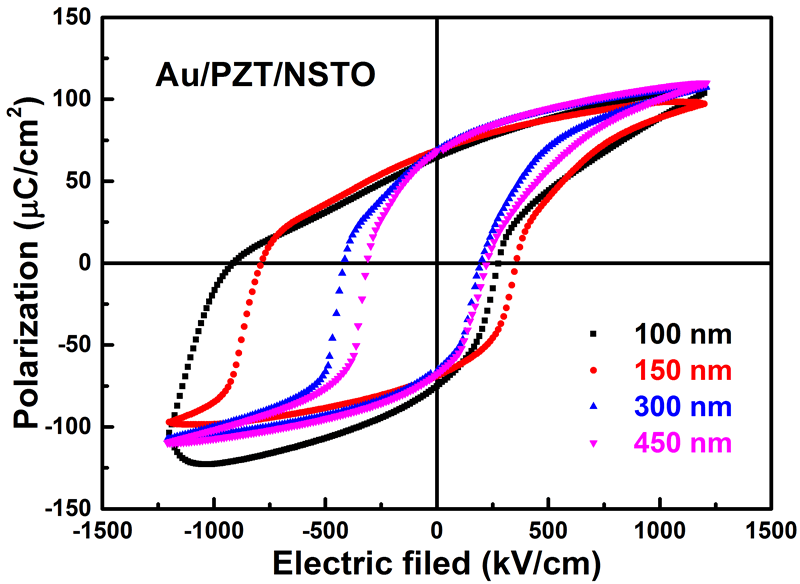
Resistive switching and modulation of Pb(Zr0.4Ti0.6)O3/Nb:SrTiO3 heterostructures |
|
A resistive random access memory (RRAM), which exhibits a high ratio of resistive switching (ON/OFF ratio), has been one of the most attractive next-generation nonvolatile memories because of its non-destructive operation, simple structure and high storage density. Recently, on the basis of ferroelectric field effect which means the semiconductor surface can be switched between accumulation and depletion of majority carriers by polarization reversal in ferroelectric thin films, the large ON/OFF ratios have been reported in ferroelectric/semiconductor heterostructures. However, the performances vary greatly different even for the same material and device structure. For these ferroelectric semiconducting films, the ferroelectricity and conductivity are directly determined by the thickness of ferroelectric films. To enhance the ON/OFF ratio, it is a main approach to modulate the potential barrier height or barrier thickness by ferroelectric polarization at the ferroelectric/electrode interfaces, which is also closely related to the thickness of ferroelectric films. In this work, epitaxial Pb(Zr0.4Ti0.6)O3 (PZT) thin films with different thicknesses were grown on Nb-doped SrTiO3 (NSTO) single-crystal substrates by chemical solution deposition, and their ferroelectric resistive switching behaviors were investigated. The results show that the maximum ON/OFF ratio up to 85000% can be obtained in the PZT/NSTO heterostructure with the 150-nm-thick PZT film. Based on the Schottky-Simmons model and the modified semiconductor theory, we also evaluated the interfacial build-in field and the depletion layer at the PZT/NSTO interface, which can be modulated strongly by the ferroelectric polarization, but are independent with the thickness of PZT thin films. When the polarization direction points to the PZT/NSTO interface after applying a negative electric field, the majority carriers in the NSTO will be attracted to the PZT/NSTO interface region by the positive polarization charges, so the built-in electric field and the width of the depletion layer decrease. This condition corresponds to the low-resistance state in the resistive switching behavior. In contrast, When the polarization direction points to the PZT surface after applying a positive electric field, the built-in electric field and the width of depletion layer increase. This condition corresponds to the high-resistance state in the resistive switching behavior. When the PZT film is too thin, the depletion layer occupies a considerable proportion in the PZT film, so that the modulation effect of ferroelectric polarization on the depletion layer becomes smaller. On the contrary, although the modulation effect of ferroelectric polarization on the depletion layer may become powerful in the thicker films, the conductive property of PZT films tends to decrease with increasing their thickness. In this situation, the volume resistance becomes crucial than the interfacial effect. Therefore, it is clear that the ferroelectric resistive switching is related to the ferroelectric polarization and modulated by the ferroelectric film thickness. These conclusions are of great significance for the devices of ferroelectric/semiconductor heterostructure to further improve their resistive switching properties. Related research results have been published in ACS applied Materials & Interfaces 8 (2016) 32948-32955.
Fig.1 (a) Schematic of the Au/PZT/NSTO heterostructure under an applied electric field (DL represents “depletion layer”), (b) Maximum ON/OFF ratio of the PZT/NSTO heterostructure as a function of the PZT thickness, (c) and (d) Band structure diagrams for the PZT/NSTO heterostructure in the different states: (c) in the state of polarization downward (LRS), and (d) in the state of polarization upward (HRS).
Fig. 1 P-E hysteresis loops of the PZT/NSTO heterostructures with different PZT thicknesses.
|
|

